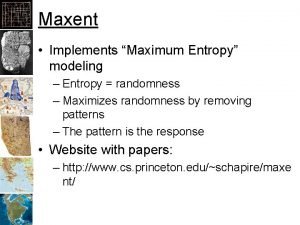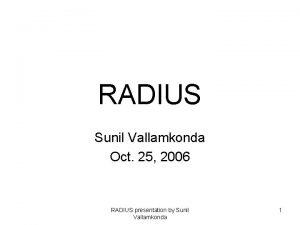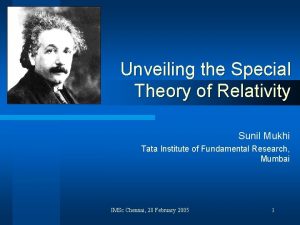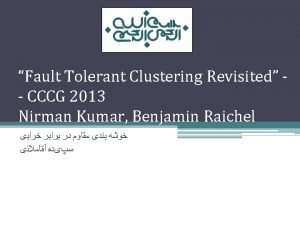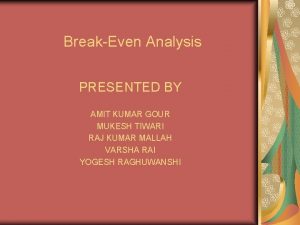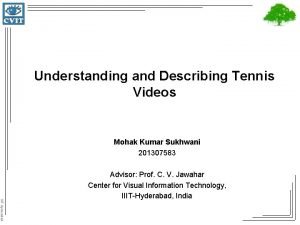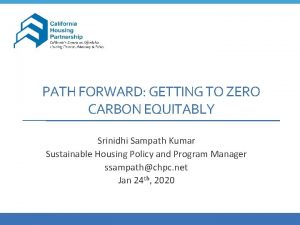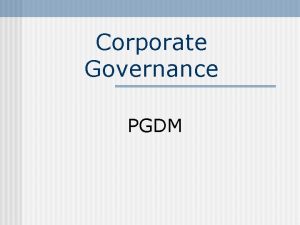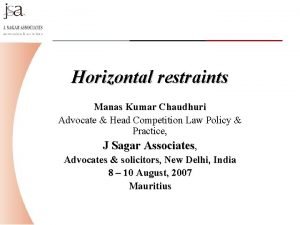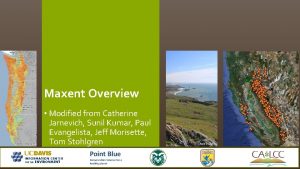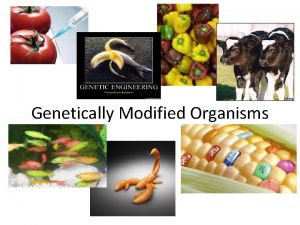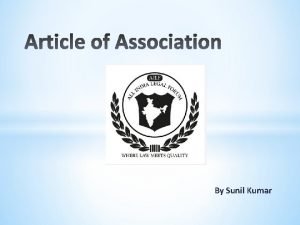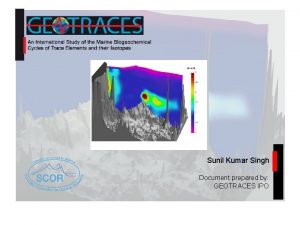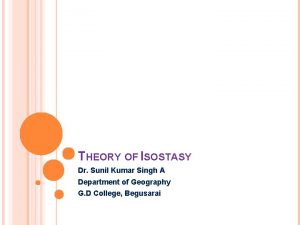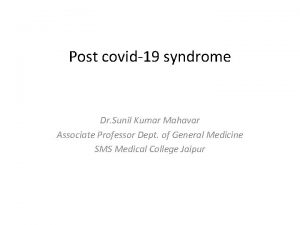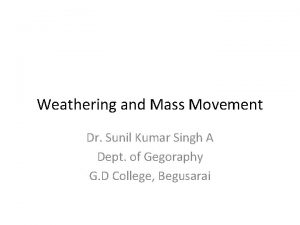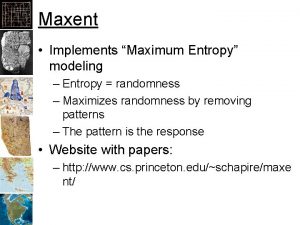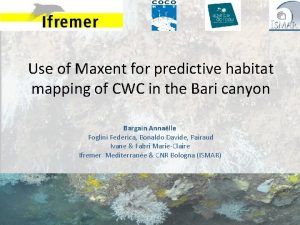Maxent Overview Modified from Catherine Jarnevich Sunil Kumar










































- Slides: 42

Maxent Overview • Modified from Catherine Jarnevich, Sunil Kumar, Paul Evangelista, Jeff Morisette, Tom Stohlgren Ryan Di. Gaudio

Objectives • By the end of this section, you should be able to: • Describe, broadly, Maxent modeling and some examples of its application • Give some examples of why you would and wold not use Maxent • State the assumptions and limitations of Maxent • Describe the inputs and outputs of Maxent • Articulate what the mapped predictions from Maxent mean • Evaluate model predictive performance • Ask the most important questions when handed a Maxent model

Why Maxent for this Workshop • Don’t have time for all methods • Heavily used in the literature and well known • Consistently performs as well or better than other methods in comparisons • One of the more approachable methods 3 September 2013 Best Practices for Systematic Conservation Planning

Background: The model • Maxent is a general purpose method that makes predictions from incomplete information • Machine learning method • Used in many fields • Generative approach • Estimates an unknown probability by finding the probability distribution of maximum entropy given some constraints

Background: Specifically for SDM • Developed by Steven Phillips at AT&T Labs. Research • Many applications • Often termed ‘Presence-only’, but closer to resource availability • Provides a model of habitat suitability

Why Use Maxent • Best suited for exploratory or opportunistically collected data • Presence only data • Maximize the utility of publically available museum and herbaria data • Small number of occurrences • Poor or absent information on sampling methods • Not confident in absences • Continually performs well in comparison with other methods

Reasons to Not Use Maxent • No amount of statistical modeling can compensate for poor definition of the problem (Austin, 2002) • Have robust sampling method with confidence presence and absence data • Somewhat of a black box compared to other methods • Statistics are still new and underdeveloped 7 September 2013 Best Practices for Systematic Conservation Planning ?

Applications • Find correlates to species distributions • What might be important drivers to a species distribution Journal of Zoology Volume 279, Issue 1, pages 27 -35, 13 MAY 2009 DOI: 10. 1111/j. 1469 -7998. 2009. 00585. x http: //onlinelibrary. wiley. com/doi/10. 1111/j. 1469 -7998. 2009. 00585. x/full#f 2

Applications • Map/predict current distributions • Conservation area delineation • Identify new, undocumented populations • New populations of endangered species • Identify population for early detection and rapid response Heikkinen et al. 2007

Applications • Predict to new time or locations • Evaluate how projected changes in climate will impact distributions • Identify the potential distribution of an invasive species Diversity and Distributions Volume 13, Issue 4, pages 476 -485, 1 JUN 2007 DOI: 10. 1111/j. 1472 -4642. 2007. 00377. x http: //onlinelibrary. wiley. com/doi/10. 1111/j. 1472 -4642. 2007. 00377. x/full#f 3

Assumptions and Limitations • Individuals have been sampled randomly across landscape • Sampling unit of size equal to the grain size of available environmental data

Assumptions and Limitations • Environmental variables represent all factors that constrain the geographical distribution of the species • Species is in equilibrium with its environment • Background locations are representative of the available environment and address bias

Assumptions and Limitations • Occurrences represent the intended response of interest

Assumptions and Limitations • Cannot estimate prevalence with presence-only • Two species can have • Same range • Same distribution of occurrences • Ones is rarer CPAW • Sample selection bias (more on this later) • Background locations are treated as pseudo-absences for model evaluation NPS

The inputs • Presence locations • Background locations • Random or user provided • Environmental information (for presence and background)

The inputs • ASCII grids of area of interest (optional) • Sampling effort (optional) • Test points (optional) • Projection ASCII grids (optional)

Maxent Graphical User Interface 17 September 2013 Best Practices for Systematic Conservation Planning

Features • Linear • Threshold • Quadratic • Hinge • Product • Categorical Product of two variables (X 1*X 2) 18 September 2013 Best Practices for Systematic Conservation Planning Binary classification

Settings • Features 19 September 2013 Best Practices for Systematic Conservation Planning Sample size Feature type > 80 All 15 – 79 Linear, quadratic, hinge 10 – 14 Linear, quadratic < 10 Linear

Settings • Output format • Logistic • 0 -1 values • Most common – Index of habitat suitability • Raw • Relative occurrence rate • Cumulative • Sum of all raw values less than or equal to the raw value at that location scaled to be between 0 -100 20 September 2013 Best Practices for Systematic Conservation Planning

Settings • MESS analysis • Testing • Regularization • Replicates 21 September 2013 Best Practices for Systematic Conservation Planning

More Settings • Extrapolate • Clamping on • Bias file 22 September 2013 Best Practices for Systematic Conservation Planning Clamping off

Outputs • Html file • model. Results. csv • AUC evaluation • Many different threshold values • Variable importance • Continuous probability prediction map • . asc file with no projection defined • MESS map (more on this later)

Omission rate • Comission • Type I error rate = False positive = null is true = crying wolf with no wolf • Omission • Type II = False Negative = alternative is true = Failing to raise alarm when there is a wolf 24 September 2013 Best Practices for Systematic Conservation Planning

• Area Under the Curve (AUC) • Sensitivity • True positive rate (% of correctly classified positives) • Specificity True Positive Rate Receiver-operating characteristic (ROC) • True negative rate (% of correctly classified negatives) • Range 0 – 1 25 September 2013 Best Practices for Systematic Conservation Planning False Positive Rate

Picture of Predicted Model Logistic mean map 26 September 2013 Best Practices for Systematic Conservation Planning Standard deviation

Thresholds 27 September 2013 Best Practices for Systematic Conservation Planning

Freeman, E. A. , & Moisen, G. G. (2008). A comparison of the performance of threshold criteria for binary classification in terms of predicted prevalence and kappa. Ecological Modelling, 217(1), 48 -58. 28 September 2013 Best Practices for Systematic Conservation Planning

Response Curves • Two types Variable is varied while all other variables held at the mean – look at changes in logistic prediction 29 September 2013 Best Practices for Systematic Conservation Planning Model is run with only one variable – better for interpretations if there are correlations

Variable Contributions • Percent contribution • Calculated during model development from changes in the gain • Permutation importance • Each variable's values are changed at the training and background locations and the model re-evaluated • Large change in metrics = high contribution in model 30 September 2013 Best Practices for Systematic Conservation Planning

Jackknife • How variables contribute to model performance 31 September 2013 Best Practices for Systematic Conservation Planning

Model documentation 32 September 2013 Best Practices for Systematic Conservation Planning

Results csv • Contains much of the information displayed in the html file 33 September 2013 Best Practices for Systematic Conservation Planning

Target background – accounting for bias • Sensitive to sampling bias • Same bias in background cancels out Random background Phillips et al, 2009, Ecological Applications 19: 181 -197. Sampling effort Targeted background

35 September 2013 Best Practices for Systematic Conservation Planning

Multivariate environmental similarity surface (MESS) Maps • Novel Environments • Conditions that are outside the environmental range used to develop the model • M 0 del predictions into these locations should be interpreted with caution 36 September 2013 Best Practices for Systematic Conservation Planning

Regularization = 0. 5 37 September 2013 Best Practices for Systematic Conservation Planning Regularization = 1. o Regularization = 2. o

Checking for Overfitting • Test and Train AUC difference • >0. 05 may be overfit • Response curves ecologically plausible? • Prediction patchy? 38 September 2013 Best Practices for Systematic Conservation Planning

Evaluating Maxent Models and Predictions • Ecological plausibility • Threshold independent metrics • Receiver-operating characteristic (ROC) of the area under the curve (AUC) • Threshold dependent metrics • Many (Kappa, True Skill Statistic), but problems with threshold selection and background points used • Independent data set • Where are the novel areas • Checks for overfitting

Questions to Ask • What is the source of the occurrence data? • How did you define the background? Why? • Where there any signs of overfitting? • Where are the novel areas? • If threshold used, ask why that threshold was chosen • Merow et al. (2013) provide a great guideline on the important decision that need to be made for a Maxent model 40 September 2013 Best Practices for Systematic Conservation Planning

41 September 2013 Best Practices for Systematic Conservation Planning

Settings • Output format • Logistic • 0 -1 values • Most common – Index of habitat suitability • Raw • All values sum to 1 • Relative occurrence rate • Cumulative • Omission rate • Sum of all raw values less than or equal to the raw value at that location scaled to be between 0 -100 42 September 2013 Best Practices for Systematic Conservation Planning
 Maxent.bat
Maxent.bat Sunil dhola
Sunil dhola Dr l sunil chandran
Dr l sunil chandran Sunil vallamkonda
Sunil vallamkonda Sunil khatri tamu
Sunil khatri tamu Sunil batra nsdl
Sunil batra nsdl Supply chain management sunil chopra 6th edition ppt
Supply chain management sunil chopra 6th edition ppt Sunil thapar
Sunil thapar Sunil paudel
Sunil paudel Illusion of asymmetric insight
Illusion of asymmetric insight Sunil mukhi
Sunil mukhi Sunil gupta bmcc
Sunil gupta bmcc Robertson cooked meat medium
Robertson cooked meat medium Rocketgtp
Rocketgtp Sudha chandran artificial leg
Sudha chandran artificial leg Kumar mangalam birla committee
Kumar mangalam birla committee Kumar venkitanarayanan
Kumar venkitanarayanan Pyelomyotomy
Pyelomyotomy Nirman kumar
Nirman kumar Kamal kumar ips
Kamal kumar ips Mahendra kumar fiji
Mahendra kumar fiji Bedford interview skills
Bedford interview skills Ifcsi
Ifcsi Kumar
Kumar Lokesh kumar jangid
Lokesh kumar jangid Rohtash kumar vs state of haryana
Rohtash kumar vs state of haryana Kumar
Kumar Kumar n. sivarajan
Kumar n. sivarajan Kumar samrudhi society
Kumar samrudhi society Customer relationship management kumar
Customer relationship management kumar Kumar
Kumar Col 106 amit kumar
Col 106 amit kumar Uiuc cs 445
Uiuc cs 445 S2sn
S2sn Mohak kumar
Mohak kumar Kumar satish ravi
Kumar satish ravi Santosh kumar swain kiit
Santosh kumar swain kiit Srinidhi sampath kumar
Srinidhi sampath kumar Rajesh kumar bhagat
Rajesh kumar bhagat Eprg framework
Eprg framework Kumar mangalam birla committee
Kumar mangalam birla committee Kumar is producing the photoelectric effect by using
Kumar is producing the photoelectric effect by using Manas kumar chaudhuri
Manas kumar chaudhuri
